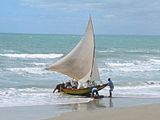
Marsaxlokk is a small, traditional fishing village in the South Eastern Region of Malta. It has a harbour, and is a tourist attraction known for its views, fishing and history. As of March 2014, the village had a population of 3,534. The village is also known for the Marsaxlokk Market, which is mainly a large fish market which takes place along the seafront on Sundays, and a tourist market during all other days of the week. Inhabited and well-known since antiquity, Marsaxlokk was used as a port by Phoenicians, Carthaginians and also has the remains of a Roman-era harbour. Originally a part of the city of Żejtun, the fishing village became a separate parish in the late nineteenth century.
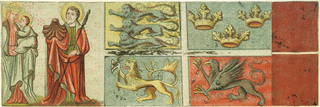
A maritime flag is a flag designated for use on ships, boats, and other watercraft. Naval flags are considered important at sea and the rules and regulations for the flying of flags are strictly enforced. The flag flown is related to the country of registration: so much so that the word "flag" is often used symbolically as a metonym for "country of registration".

A pilot boat is a type of boat used to transport maritime pilots between land and the inbound or outbound ships that they are piloting. Pilot boats were once sailing boats that had to be fast because the first pilot to reach the incoming ship got the business. Today, pilot boats are scheduled by telephoning the ship agents/representatives prior to arrival.

Qala is an administrative unit of Malta, on the island of Gozo, with a population of 1,929 as of September 2019. Nearby is Ħondoq ir-Rummien, a coastline with salt pans and caves.

The kajjik or kajjikk is a traditional fishing boat from Malta. It developed in the 17th century from caïques which were used elsewhere in the Mediterranean. In the past, kajjikki were equipped with sails and oars, but today the fishing boats are powered by inboard motors. Variants of the boat participate in the rowing regattas held twice every year.
Lampuki is the Maltese name for the dorado or mahi-mahi, a kind of fish that migrates past the Maltese islands during the autumn. The fishing season for lampuki is from 15 August through to the end of December, in accordance with Article 12 of Regulation (EU) No. 1343/2011 of the European Parliament and of the Council of 13 December 2011.

A caïque is a traditional fishing boat usually found among the waters of the Ionian or Aegean Sea, and also a light skiff used on the Bosporus. It is traditionally a small wooden trading vessel, brightly painted and rigged for sail. The caïque is also a typical case of positioning the widest beam far aft, with a long sharp bow.
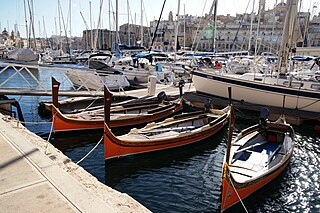
The dgħajsa tal-pass is a traditional water taxi from Malta. It is often simply referred to as the dgħajsa, but this word refers to any type of boat in the Maltese language. The boat developed in the 17th century, and was extensively used to ferry passengers in the Grand Harbour and Marsamxett Harbour between the 18th and 20th centuries. Their use declined in the late 20th century, and today only a few dgħajjes remain in operation, ferrying tourists around the harbours. Variants of the boats are still used extensively in rowing regattas held twice a year.
Ħondoq ir-Rummien, the coastline below the village of Qala, Gozo, Malta is dotted with traditional salt pans, some of which are still actively used to harvest salt throughout the summer months. On this coast is a small cove, Ħondoq ir-Rummien, which is used by snorkelers because of its deep and clear water and the small caves at sea level. The cove has a view of Comino. There is also a small white sand beach sheltered by a small promontory on the southwest side.

A fishing vessel is a boat or ship used to catch fish and other valuable nektonic aquatic animals in the sea, lake or river. Humans have used different kinds of surface vessels in commercial, artisanal and recreational fishing.
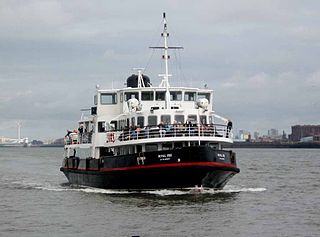
MV Royal Iris of the Mersey is a Mersey Ferry in operation on the River Mersey, England. From launch in Devon in 1959 until a major refurbishment in 2001, she was named MV Mountwood.

A Dutch barge is a traditional flat-bottomed shoal-draught barge, originally used to carry cargo in the shallow Zuiderzee and the waterways of Netherlands. There are many types of Dutch barge, with characteristics determined by regional conditions and traditions.

Traditionally, many different kinds of boats have been used as fishing boats to catch fish in the sea, or on a lake or river. Even today, many traditional fishing boats are still in use. According to the United Nations Food and Agriculture Organization (FAO), at the end of 2004, the world fishing fleet consisted of about 4 million vessels, of which 2.7 million were undecked (open) boats. While nearly all decked vessels were mechanised, only one-third of the undecked fishing boats were powered, usually with outboard engines. The remaining 1.8 million boats were traditional craft of various types, operated by sail and oars.

The Gozo boat was a type of settee-rigged boat originating from Malta. Gozo boats were the main means of transport across the Gozo Channel between Gozo and the main island of Malta from the late 19th to the mid-20th century. The design of the boats developed from the speronara.
Simshar incident refers to an incident whereby four people died before or after an explosion took place aboard a fishing vessel named Simshar off the eastern coast of Malta. The incident took place on July 11, 2008.
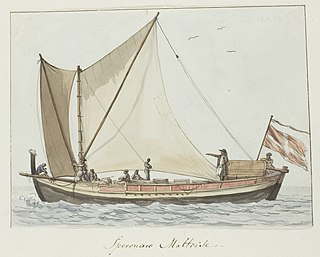
The speronara was a type of small merchant craft originating from Malta which was used in the Mediterranean from the 16th to the early 20th centuries. The vessels usually had no deck and only one mast, often with a lateen or sprit sail. Some larger vessels had a half deck or up to three masts.

Perahu Mayang or simply mayang is a type of fishing boat from Java, Indonesia. This type of boat is used mainly for fishing and trading. Historically, this indigenous vessel is also favored by European skippers and private merchants for trading in East Indies: 50% of them were using mayang and pencalang. It is mostly used in northern coast of Java. The major production site is in Rembang, Central Java.
The 1948 Gozo luzzu disaster occurred on 30 October 1948 when a luzzu fishing boat carrying passengers from Marfa, on the island of Malta, to Mġarr, Gozo, capsized and sank in rough seas off Qala, in the colony of Malta, killing 23 of the 27 people on board. Inquiries held after the accident determined that the boat had been overloaded as it was carrying around double its capacity.

The ferilla or firilla is a traditional fishing boat from Malta. It bears similarities to the dgħajsa, but it is of stronger construction. The ferilla developed in the 17th century and it was common until about 1900. Some examples of this boat type still exist but they are rare.

Luzzu is a 2021 Maltese drama film written and directed by Alex Camilleri. The film stars Jesmark Scicluna, Michela Farrugia and David Scicluna.


















